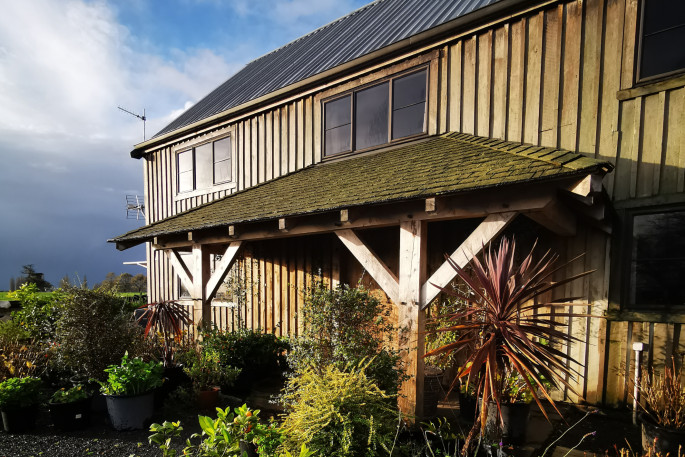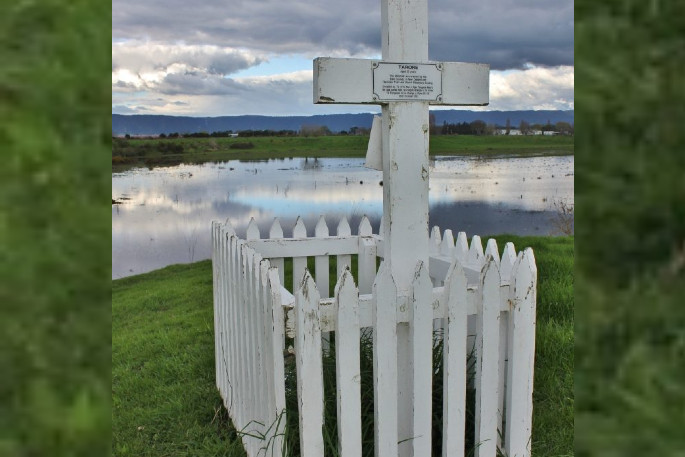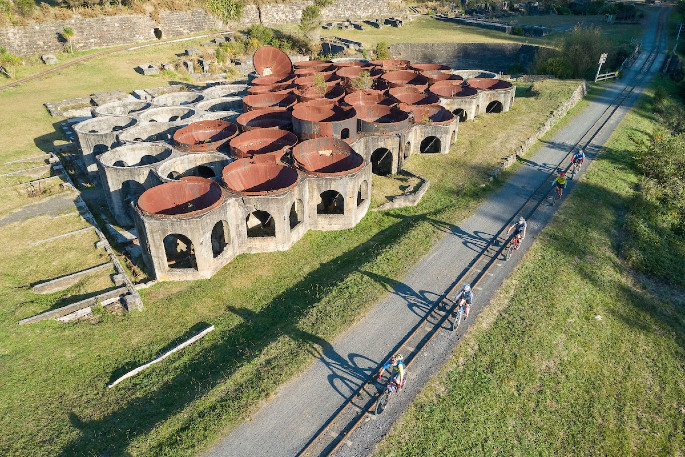Wairere Falls, the highest waterfall in New Zealand's North Island, has been kicking it with what one observer calls 'a forceful torrent” this week.
'The usually gentle, cascading water at Wairere Falls [is] replaced by a forceful torrent following the severe weather,” says a Hauraki Rail Trail spokesperson on their Facebook page.
The photo, taken by Jen Roberts from Wardville's House with No Nails shows thousands of litres of water plunging 153 metres in what is usually two steps over the Kaimai escarpment. The waterfall is located between Te Aroha and Matamata.
'I took that photo zooming in from my mobile phone sitting in the car looking directly up at it,” says Jen.
Jen had driven some German backpackers up near the falls as part of her House with No Nails service before they went to Hobbiton.
'They were bussing through the country, and had no car, so I drove them around and dropped them off. Glanced up and saw the waterfall, it was looking magnificent.”
The Wairere Falls is part of the Okauia fault line which has created a series of gorges and valleys in the Kaimai Range.
'Because I look at it from the barn every day I knew that after a a day or two when it stops raining it will be gone, just hardly dribbling, because it has an escarpment catchment up the top and drains away afterwards.”

Jen Roberts has a view of the Kaimai Range from the House with No Nails. Photo: Jen Roberts.
Jen says another interesting factor about the falls – which she calls ‘story tourism' is some of the early history surrounding the area.
'It's also a historic walkway for Maori when they crossed over from the Waikato to the Bay of Plenty,' says Jen.
Legend has it that Ngahue came to New Zealand from Rarotonga on the back of a fish and walked over the Wairere track from Tauranga.
After travelling overland he brought back some greenstone and killed a moa at the bottom of the falls before returning to his homeland.
The Wairere Track for ever after was to provide a link between Matamata and the Bay of Plenty. It was a traditional route for Māori and was later also used by missionaries, explorers and scientists.
Sadly the Wairere track was also the scene for the murder of a young Māori girl, Tarore, in 1836.
'There is an amazing story about a chief's daughter Tārore who loved to read,” says Jen. 'Her cemetery plot is in Waharoa.”

Tārore is buried in Waharoa. Photo: Supplied.
Tārore was taught to read from the te reo Māori Gospel of Luke, from the Bible, by Charlotte Brown of the Church Missionary Society from the age of ten. She was considered a prodigy because of her ability to memorise much of the book. She would recite portions of the Gospel to crowds of 200–300 of her people.
'It had become very unsafe for children in Waharoa so a chief arranged to take the children over the waterfall,” says Jen.
History accounts record that in October 1836, Tarore was evacuated with the other pupils from her CMS school in Matamata, because of a violent conflict between iwi. She took her father's rare te reo Māori Gospel of Luke in a small kete she wore around her neck. Whilst stopped for the night of October 18 near the Wairere Falls, her party of 24, including her peace-loving father, was attacked by a Ngāti Whakaue war party from Rotorua.
Tārore was murdered and the book stolen by warrior Paora Te Uita. Her body was carried back to the Matamata mission station and was given a Christian burial. The Māori law of utu required revenge for her death, but at her tangi her Christian father spoke words of forgiveness and said "do not rise up to obtain satisfaction for her. God will do that”.
'Back then it was eye for eye and tooth for tooth,” says Jen. 'They thought she had a gem on her neck as she had a woven basket, but it was the book of John and the theme of the book was forgiveness. That book was taken down the South Island and it transformed lives.”
Several weeks following Tārore's death, back in Rotorua, Uita asked visiting ex-slave, mission school educated Ripahau of Ngāti Awa to explain the book to him. This led him to become a Christian and to ask for forgiveness from Ngākuku, leading to their reconciliation. The book, identified by Ngākuku's inscribed name, was then taken south and ended up in the hands of Ripahau again in Ōtaki. It continued to play a key role in Māori evangelising to Māori for years to come, including the introduction of the Gospel to the South Island for the first time.
Today the old ‘Māori' track as it is known, is rarely used however a new track has been built which contains 121 steep stairs. This walking track, which leads to the top of the falls, can be accessed via the carpark on Goodwin Road. There is one lookout halfway up the Wairere Falls track and it is a medium walk to this point, however it gets a little harder going to the top of the waterfall. It is approximately an hour and a half walk to the top of the falls where breathtaking views can been seen. It takes approximately the same amount of time to make the return journey down.
'The 5km walking track weaves its way through moss covered rocks, tree roots, nīkau, pūriri and kohekohe, leading to a lookout with spectacular views of the falls,” says a Hauraki Rail Trail spokesperson. 'Make time for this dramatic detour on foot after your ride from Te Aroha to Matamata.”
The Hauraki Rail Trail section from Paeroa to Te Aroha is closed at present due to flooding this week.
'The Trail is currently impassable south of Mangaiti through to Te Aroha. The trail section between Te Aroha and the Tirohia Paeroa-Tahuna Road is impassable until the flood water subsides,” says a Hauraki Rail Trail spokesperson.

Section D of the Hauraki Rail Trail from Paeroa to Te Aroha is closed this week due to flooding. Image: Hauraki Rail Trail.
'There is waist deep levels of water over the trail at a number of locations and in and around the Coulter Bridge in Te Aroha. We have been advised that Mace Road out of Te Aroha is closed due to flooding which also includes the trail heading towards Te Aroha West.”

The Victoria Battery on the Hauraki Rail Trail. Photo: Supplied.
People are advised that when walking up Wairere Falls there can be some very slippery steps with a hazardous 90 metre drop off to the side of these steps.
'It is not recommended that hikers take this track on a wet day.”



0 comments
Leave a Comment
You must be logged in to make a comment.